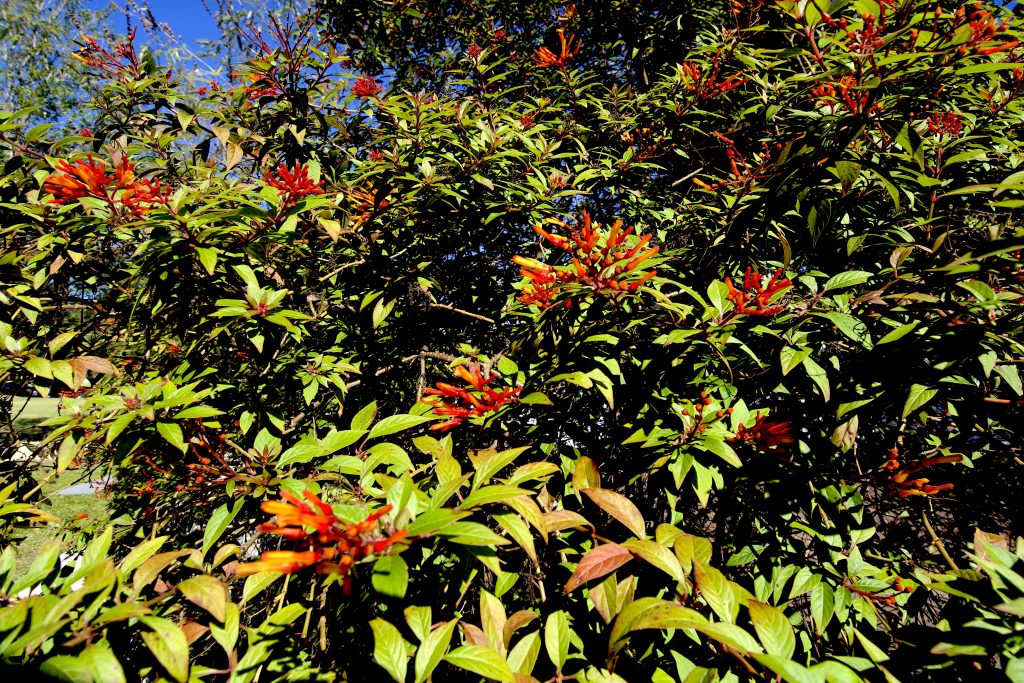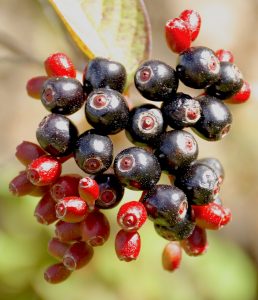
The ornamental Firebush in bloom. Photo by Green Deane
Hamelia patens: Edible pharmaceutical
The Firebush is probably one of the most commonly planted unknown edibles. They are usually arranged in the landscape to attract butterflies and migratory or resident humming birds. However the fruit is edible — with precautions — and the plant has a long history of medicinal and industrial uses.

Red berries ripen to black. Photo by Green Deane
It would be difficult to make a better consumer lawn shrub than the Firebush. It is showy, fast-growing, evergreen, stays small, attracts birds and insects and provides an edible fruit. It blossoms all year with tubular flowers, reddish-orange or scarlet. Even the stems of the flowers are red. The fruit is a juicy berry with a lot of little seeds. It ripens from green to yellow to red then black. It can be eaten out of hand — more on that in a moment — made in to a syrup or wine, a particular favorite in Mexico. It can fruit nearly all year unless damaged by cold. The berry is deceptive raw. It has an initial sweetness and grape-like texture that yields a sticky, lingering, slightly bitter aftertaste in the back of the mouth. Try one first, not a lot. See if you like it. Some people don’t taste that so it might be a genetic trait. Cooking eliminates that aftertaste.
The Mayans called it, Ix-canan, or “guardian of the forest.” In Belize the Firebush is used to treat a variety of skin problems including, sores, rashes, wounds, burns, itching, cuts, skin fungus, and insect stings and bites. For topical use they boiling two handful of leaves, stems and flowers in two gallons of water for 10 minutes. Once cool, it is applied liberally to the affected area. This same liquid is drank as a tea to relieve menstrual cramps. The Choco Indians in Panama drink a leaf infusion to treat fever and diarrhea; the Ingano Indians make a leaf infusion for intestinal parasites. Tribes in Venezuela chew on the leaves to lower body temperature to prevent a sun or heat stroke. In Brazil the root is used as a diuretic, the leaves for scabies and headaches. Cubans use the leaves externally for headaches and sores while a decoction is taken internally for rheumatism. In Mexico it is used externally to stop staunch to flow of blood and heal wounds.
In the lab animal studies with Firebush leaf extracts showed analgesic, diuretic, and hypothermic actions. External use showed significant anti-inflammatory activity. The bush also antibacterial and antifungal properties against a wide range of fungi and bacteria in several. Also, incisions bathed with plant juice healed faster and stronger than no bathing or application of petroleum jelly.
The industrial use of the plant comes from it high amounts of tannins. The hard, brown wood has also been used. Firebush’s botanical name is Hamelia patens. Hamelia honors French botanist Honri Louis Du Hamel du Monceau and is said: huh-MEE-lee-uh. Patens, said PAY-tenz, means spreading.
Firebush Catsup
Ingredients:-
2 cups ripe berries
½ cup mild vinegar
2/3 cup water
1 cup brown sugar
½ tsp each of clove, ginger and paprika
1 tsp cinnamon
½ tsp salt
Put into a saucepan the berries, vinegar and water. Boil the berries until they are soft (5 minutes). Put through a blender or food processor. Then add the sugar, spices and salt. Simmer for 3 minutes. Serve at room temperature.
Carambola and Firebush Chutney
4 cups carmbola, peeled and pipped, cut into small pieces
¼ cup ripe berries
2 cups vinegar
2 cups sugar
¼ cup finely chopped ginger
Put in a heavy saucepan vinegar and sugar and bring to boiling point. Add the carambola and ginger. Cook on low heat for 2 hours, stirring occasionally to prevent sticking to bottom of can. Add berries in the last 10 minutes of cooking to allow then to retain their shape.
Green Deane’s “Itemized” Plant Profile
IDENTIFICATION: Shrub or small, bushy tree to 12 ft. Young branches reddish. Leaves elliptic, oblong or elliptic-ovate, pointed, 3 to 7 in. long, more or less flushed and dotted with red or purple, and with red stalks; soft-textured, hairy. Flowers scarlet, tubular, with dark linear stripes, slender, to 1 1/2 in. long, in tassel-like, branched clusters. If the flowers are more yellow than red and without stripes it is probably the H. patens var glabra from Mexico, presumed to be edible. Fruit ovalish, five-pointed calyx, seedy, distinct nipple.
TIME OF YEAR: Flowers and fruits year round.
ENVIRONMENT: Common in hammocks and landscaping. It prefers damp to dry. Native to Florida but can be grown along the southern gulf coast and up the west coast to southern oregon.
METHOD OF PREPARATION: Ripe fruit is black, edible raw, can be made into a syrup or wine.


So happy to find such great info. on this lovely plant. I was pleasantly surprised to notice that it attracted humming birds , and now to discover that it is a great herbal medicine too ………….How is it propagated?
The seeds are planted.
Very easy to root in damp soil.
are there several look alikes? Or are there just that many of these bushes planted around town? always love learning about the raw edibles in Florida.
No really… they are a butterfly attracting ornamental planted everywhere locally.
Just joined your list. Here’s hoping l can maybe pick up some pointers on Wild Food in South West High Desert NM.
Charles Clark (Fuzz)
Trust me. I have three of them for years and they attract hummingbird and butterflies. I have made jelly out of the ripe black berries which have little taste eaten raw. But taste great when you make jelly or jam. Also the leaves, when boiled until the water turns light orange makes the best tasting tea I have ever had! I don’t know about the medicinal affect, but the tea tastes great.
Do u know the ratio of juice to sugar for fire bush jelly? Any instructions would be welcome
My garden is surrounded most of the perimeter with them and so it must have been a humming bird that surprised me – butterflies too and all this in North Thailand – must try the tea Electric hedge trimming is so easy too.
This is so cool! I love finding new natural resources. If only it were profitable to “manufacture”. That way more people would have access to these non-toxic healing properties!
Thanks for the info.
Check out CelSana. A relatively new company founded by a retired heart surgeon, who developed an extract from the leaves of this plant.
Amazing products for application to your skin with anti-aging properties. Eight week clinical study on the products and an 8 week money back guarantee.
Where can I buy this product?
Great information on this beautiful plant
Easily the favorite of all the critters in my garden.
I started with one plant that has grown to 8+feet high and across. I guess thanks to the birds I now have lots of these plants popping up everywhere. I l knew my chickens loved the berries but nice to know they are edible for people. Will have to try the berries and the tea
About making the tea… do you usually drink it fresh? Could the leaves be dried for teas? Do some of these cultures, or any other readers, dry them for later use?
I think I saw this in El Salvador– can’t be sure as I’m going off memory and don’t know this plant well. The fruit definitely looked like the picture.
I asked my hosts whether it was edible, since they had many edible plants on the property, and they said the fruits don’t taste good, but they use them medicinally.
Found one sprouting in my garden, don’t know how it got there but I am grateful it is!